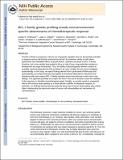| dc.contributor.author | Gilbert, Luke Andrew | |
| dc.contributor.author | Meacham, Corbin Elizabeth | |
| dc.contributor.author | Jiang, Hai | |
| dc.contributor.author | Hemann, Michael | |
| dc.contributor.author | Pritchard, Justin R. | |
| dc.contributor.author | Shingleton, Jennifer R. | |
| dc.contributor.author | Lauffenburger, Douglas A | |
| dc.date.accessioned | 2013-01-08T21:53:58Z | |
| dc.date.available | 2013-01-08T21:53:58Z | |
| dc.date.issued | 2011-07 | |
| dc.date.submitted | 2011-06 | |
| dc.identifier.issn | 0008-5472 | |
| dc.identifier.issn | 1538-7445 | |
| dc.identifier.uri | http://hdl.handle.net/1721.1/76213 | |
| dc.description.abstract | The Bcl-2 family encompasses a diverse set of apoptotic regulators that are dynamically activated in response to various cell-intrinsic and -extrinsic stimuli. An extensive variety of cell culture experiments have identified effects of growth factors, cytokines, and drugs on Bcl-2 family functions, but in vivo studies have tended to focus on the role of one or two particular members in development and organ homeostasis. Thus, the ability of physiologically relevant contexts to modulate canonical dependencies that are likely to be more complex has yet to be investigated systematically. In this study, we report findings derived from a pool-based shRNA assay that systematically and comprehensively interrogated the functional dependence of leukemia and lymphoma cells upon various Bcl-2 family members across many diverse in vitro and in vivo settings. This approach permitted us to report the first in vivo loss of function screen for modifiers of the response to a front-line chemotherapeutic agent. Notably, our results reveal an unexpected role for the extrinsic death pathway as a tissue-specific modifier of therapeutic response. In particular, our findings show that particular tissue sites of tumor dissemination play critical roles in demarcating the nature and extent of cancer cell vulnerabilities and mechanisms of chemoresistance. Cancer Res; 71(17); 5850–8. ©2011 AACR. | en_US |
| dc.description.sponsorship | National Institutes of Health (U.S.) (NIH RO1 CA128803) | en_US |
| dc.description.sponsorship | National Cancer Institute (U.S.) (Integrated Cancer Biology Program grant NCI 1-U54-CA112967) | en_US |
| dc.description.sponsorship | David H. Koch Institute for Integrative Cancer Research at MIT (Ludwig Fellowship) | en_US |
| dc.description.sponsorship | Massachusetts Institute of Technology. Dept. of Biology (training grant) | en_US |
| dc.language.iso | en_US | |
| dc.publisher | American Association for Cancer Research | en_US |
| dc.relation.isversionof | http://dx.doi.org/10.1158/0008-5472.CAN-11-1014 | en_US |
| dc.rights | Creative Commons Attribution-Noncommercial-Share Alike 3.0 | en_US |
| dc.rights.uri | http://creativecommons.org/licenses/by-nc-sa/3.0/ | en_US |
| dc.source | PMC | en_US |
| dc.title | BCL-2 family genetic profiling reveals microenvironment-specific determinants of chemotherapeutic response | en_US |
| dc.type | Article | en_US |
| dc.identifier.citation | Pritchard, J. R. et al. “Bcl-2 Family Genetic Profiling Reveals Microenvironment-Specific Determinants of Chemotherapeutic Response.” Cancer Research 71.17 (2011): 5850–5858. Web. | en_US |
| dc.contributor.department | Massachusetts Institute of Technology. Department of Biological Engineering | en_US |
| dc.contributor.department | Massachusetts Institute of Technology. Department of Biology | en_US |
| dc.contributor.department | Koch Institute for Integrative Cancer Research at MIT | en_US |
| dc.contributor.mitauthor | Pritchard, Justin Robert | |
| dc.contributor.mitauthor | Gilbert, Luke Andrew | |
| dc.contributor.mitauthor | Meacham, Corbin Elizabeth | |
| dc.contributor.mitauthor | Ricks, Jennifer L. | |
| dc.contributor.mitauthor | Jiang, Hai | |
| dc.contributor.mitauthor | Lauffenburger, Douglas A. | |
| dc.contributor.mitauthor | Hemann, Michael | |
| dc.relation.journal | Cancer Research | en_US |
| dc.eprint.version | Author's final manuscript | en_US |
| dc.type.uri | http://purl.org/eprint/type/JournalArticle | en_US |
| eprint.status | http://purl.org/eprint/status/PeerReviewed | en_US |
| dspace.orderedauthors | Pritchard, J. R.; Gilbert, L. A.; Meacham, C. E.; Ricks, J. L.; Jiang, H.; Lauffenburger, D. A.; Hemann, M. T. | en |
| mit.license | OPEN_ACCESS_POLICY | en_US |
| mit.metadata.status | Complete | |
